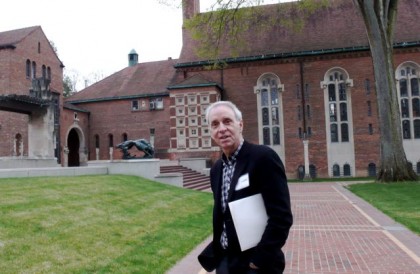
I am privileged to serve on the National Advisory Council at Cranbrook Academy of Art. Cranbrook is truly a place like no other—a stimulating, open environment where art, architecture, and design are taught and explored without boundaries. There’s a rich dialogue and a consciousness about design that doesn’t exist elsewhere.

Reed Kroloff, the school’s director, does an incredible job of bringing us together to discuss issues and what they might mean to Cranbrook. This month, our interdisciplinary group looked at social media.
Through a series of extraordinary speakers—Randy Ortiz from Chrysler Corporation, Ben Watson of Herman Miller, Inc., and Nike’s Tesa Arragones—we learned big business is using social media in very sophisticated and effective ways. For these companies, social media is a means of letting the world communicate their messages. But rather than controlling the content, they let the culture adopt and extend their ideas. Potent stuff!
Gathering public input about architecture
We have been experimenting a bit in our own practice, using social media to harvest public values and perceptions. We did a project recently with the help of Alex Gilliam of Public Workshop where we publicized an event on Facebook and then re-capped and talked about it afterward—again all on Facebook. I was moved by both the breadth and depth of input we got, and it was a lot more fun than stuffy public input sessions in fluorescent-lit community centers with the same old city hall groupies.
I am all over Facebook. I use it as a forum for dialogue in my classes, and people are always sending me cool videos, interesting links, and articles I would never find on my own.
At Cranbrook, someone asked me why I have 1500 Facebook “friends.” Of course I don’t have intimate personal dialogue with all of these people, but I have had some significant contact with them, and I really like the ability to easily reconnect. I believe social media ties into the psychology of creativity; creative people often have more loose ties than strong ones. They need input and stimulation from a lot of different people. Social media is a way of keeping that stimulus going.
Finding new ways to engage
I am looking for more ways to use social media to generate a professional dialogue about architecture and as a tool for helping us engage a broad slice of the public more readily in what we do. If businesses like Chrysler, Nike and Herman Miller have found creative ways to use it, why shouldn’t we?

As someone who studied advertising with an emphasis on social media at UT and now works in marketing for a company closely tied to the architecture industry, I found this post particularly interesting. I was nearly persuaded to study architecture based solely on your class, which was easily one of my favorites in my time at UT. Thanks for that!
Cheers –
Jennifer